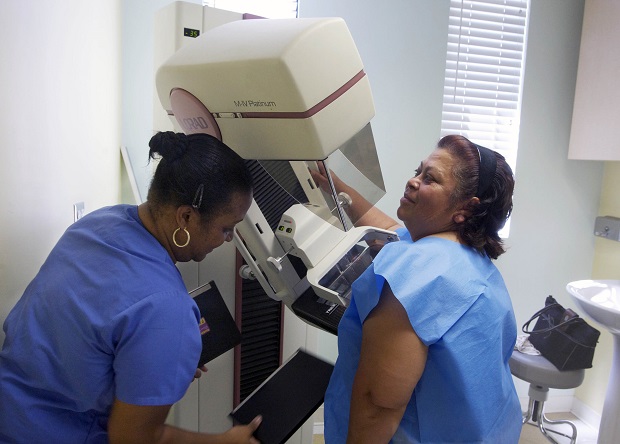Expert panel: Mammograms are most worth it for women 50-69

In this May 6, 2010 file photo, detection lead mammographer, Toborcia Bedgood, left, prepares a screen-film mammography test for patient Alicia Maldonado, at The Elizabeth Center for Cancer Detection in Los Angeles. A new, international panel of experts has studied the most recent evidence on mammograms to screen for breast cancer and says they do the most good for women in their 50s and 60s. Women 70 to 74 also benefit to a lesser extent. But evidence that screening helps women in their 40s is “limited,” the panel said, although some members disagreed this was true for women 45 to 49. AP
A new, international panel of experts has studied the most recent evidence on mammograms to screen for breast cancer and says they do the most good for women in their 50s and 60s.
Women who are 70 to 74 also benefit to a lesser extent. But evidence that screening helps women in their 40s is “limited,” the panel said, although some members disagreed this was true for women 45 to 49.
The panel’s report was published online Wednesday by the New England Journal of Medicine.
Who should get mammograms and when has long been debated, especially since 2009, when the U.S. Preventive Services Task Force said women should be screened every two years starting at age 50, and that doing so before then does little good and is a personal choice.
READ: Size doesn’t matter with breast cancer | Breast cancer still the most common among women | Filipina immigrants in Canada get breast cancer at an earlier age
The new advice gives a global perspective, coming from 29 cancer experts from 16 countries, convened by the International Agency for Research on Cancer. They include Dr. Robert A. Smith, breast cancer screening chief for the American Cancer Society, which has long recommended annual mammograms starting at age 40.
The cancer society soon will update its own guidance, said its chief medical officer, Dr. Otis Brawley. The international panel’s stance “does demonstrate that there is legitimate scientific question about screening women in their 40s,” he said.
Mammograms give many false alarms, leading to unnecessary and costly follow-up tests. They also find many cancers that never would have threatened a woman’s life, and many cancers prove fatal no matter how soon they are found. As treatments improve, the value of tests to find the disease early shrinks.
READ: Soy foods help reduce breast cancer recurrence | Study sees benefit from more extensive breast cancer surgery | How managing our stress may help us avoid breast cancer
The international group wanted to update its last advice, from 2002, taking treatment improvements into account. Panel members concluded that mammograms can cut the risk of dying of breast cancer about 40 percent for women 50 to 69.
They also said evidence is inadequate or lacking that:
—Mammograms are cost-effective in low- and middle-income countries.
—Physical breast exams, by a doctor or a woman, lower the risk of dying of breast cancer.
—Other ways to screen for the disease, such as MRI, ultrasound and tomosynthesis, cut mortality.
“We need to find a better test,” Brawley said.